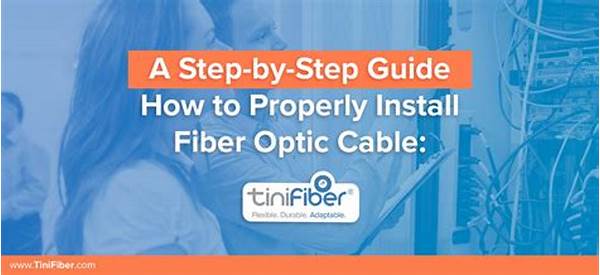Installing fiber optic audio-visual cables might not sound like the most exciting task, but trust us, it’s the backbone of a smooth home entertainment or office setup. Imagine watching your favorite movie and suddenly, the signal drops. Frustrating, right? That’s precisely why getting the installation right is crucial. Fiber optic cables offer incredible speed and reliability, and mastering their installation will save you from unwanted signal disruptions and bring peace of mind, whether you’re hosting a movie night or a critical business presentation.
Read More : Tips For Choosing A Digital Audiovisual Mixer For Small Concerts
Now, let’s face it, not everyone is born with the innate ability to handle cables like a pro. But fear not! With a few helpful tips, anyone can achieve a stable signal with their fiber optic setup. Whether you’re a DIY enthusiast or someone who usually dreads tech installations, this guide is designed to be your go-to resource. So, stick around, as we unravel the mysteries of fiber optics with a dash of humor to keep things upbeat yet informative.
The Essentials of Installing Fiber Optic Audio-Visual Cables
Understanding Your Equipment
Before you dive into the installation process, it’s crucial to familiarize yourself with the equipment and materials. Fiber optic cables are different from your usual coaxial or HDMI cables as they use light to transmit signals. This means they’re less prone to electromagnetic interference and can carry signal over long distances without loss, perfect for both grand home theaters and compact office spaces.
To start, measure the distance where the cables need to be installed. Ensure you have the right length of cable; too short, and you’ll be in a tight spot, too long, and you might have unnecessary clutter. Attention to these details reflects in achieving a stable signal, turning your tech trial into a triumphant setup.
Planning the Installation Path
Mapping out the path where your cables will run not only ensures a tidy job but also prevents potential damage to the cables. Try to keep the path simple and avoid sharp bends or turns, as these can degrade the signal. When possible, run them through walls, ceilings, or designated cable conduits. Using fish tape can assist you in threading the cable through tough spots. If things get tricky, don’t hesitate to call in a buddy or a professional service — it’s not an experience you want to tackle solo if unfamiliar.
Step-by-step Installation Tips
1. Prepare the Environment: Start by ensuring the workspace is clean. Dust and debris can interfere with the installation process, particularly where connectors are concerned.
2. Connect with Care: Fiber optic cables need gentle handling. When connecting the cables, ensure you do not bend them excessively. Properly align and secure the connections to prevent signal loss.
3. Testing the Connection: Once everything is in place, it’s time for a test run. Use testing equipment to verify each connection point and overall signal strength. This confirms the stability of the signal and showcases the quality of your installation.
Tips for a Smooth Fiber Optic Installation Process
Common Mistakes to Avoid
Even seasoned pros can make mistakes, but with fiber optic cables, some mistakes can be costly in terms of signal quality:
Read More : Benefits Of Audiovisual Sources In Historical Research Inspiring Critical Thinking
Professional Assistance: When to Call in the Experts
If DIY isn’t your cup of tea or if you’re dealing with a particularly complex setup, professional installation services are always a good backup. Call someone with the experience and tools to ensure everything is installed perfectly, saving you time and potential frustration.
Having a stable audio-visual signal isn’t just about boasting rights—though that’s always fun—it allows you to enjoy your technology investments fully. So, whether setting up a dream home theater or revamping your office conferencing systems, these tips for installing fiber optic audio-visual cables for a stable signal will become your best companions.
Achieving Perfection with Fiber Optic Installation
Key Considerations for Fiber Optic Installations
Focused planning and attention to equipment details contribute massively to seamless fiber installations. Proper handling and care go a long way in maintaining the longevity and performance of fiber optic systems. If this seems daunting, remember that patience and preparation are your best allies.
Conclusion: Your Path to a Stable Signal
Ultimately, mastering the art of installing fiber optic audio-visual cables isn’t reserved just for tech wizards. With our handy tips and a little humor along the way, anyone can become a bona fide installer. Not only will you enjoy a stable signal and superior audio-visual performance, but you’ll also gain valuable skills worthy of being the tech guru among your friends and family. Share your success stories and encourage others to dive into the world of fiber optics with confidence.
—
Remember, each home and office setup is unique, and while these tips offer a solid foundation, customizing the approach based on your specific needs will help achieve the best results. Happy installing, and may your signals never falter!
